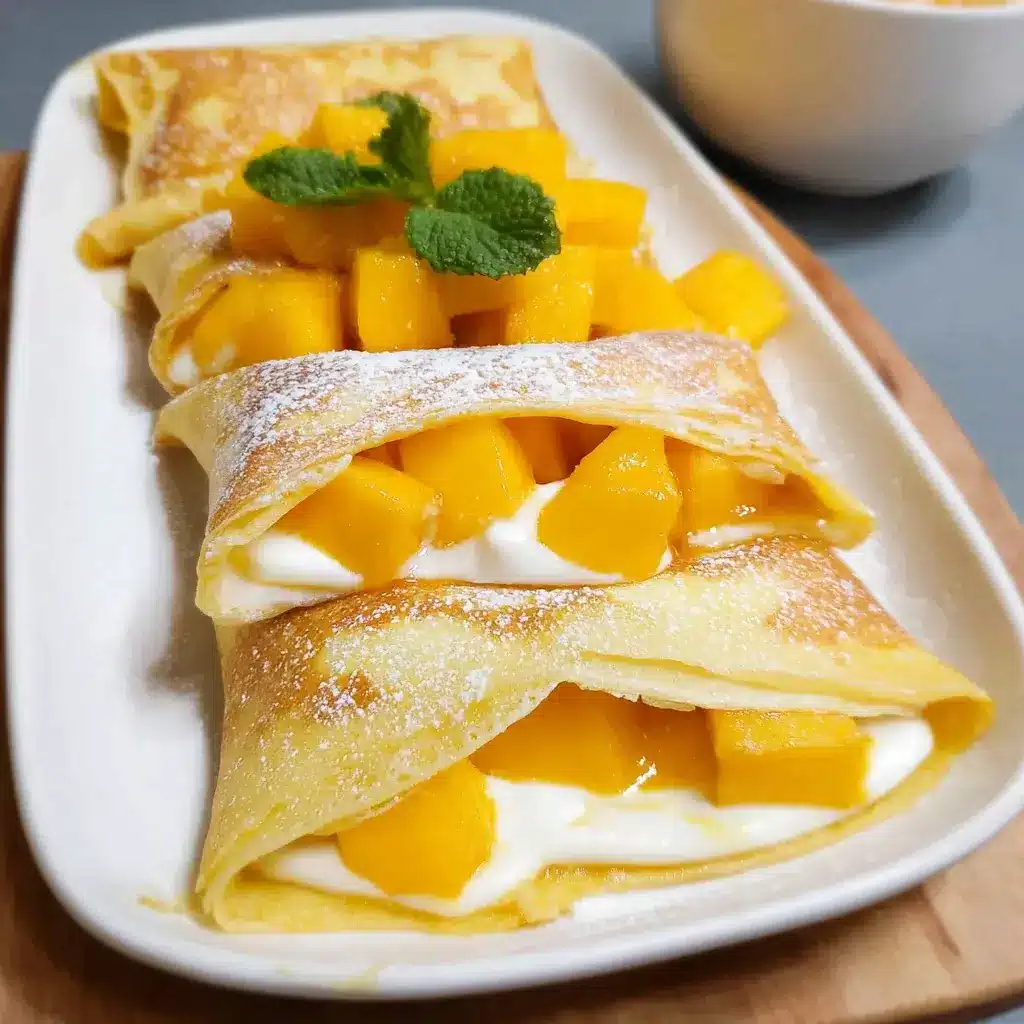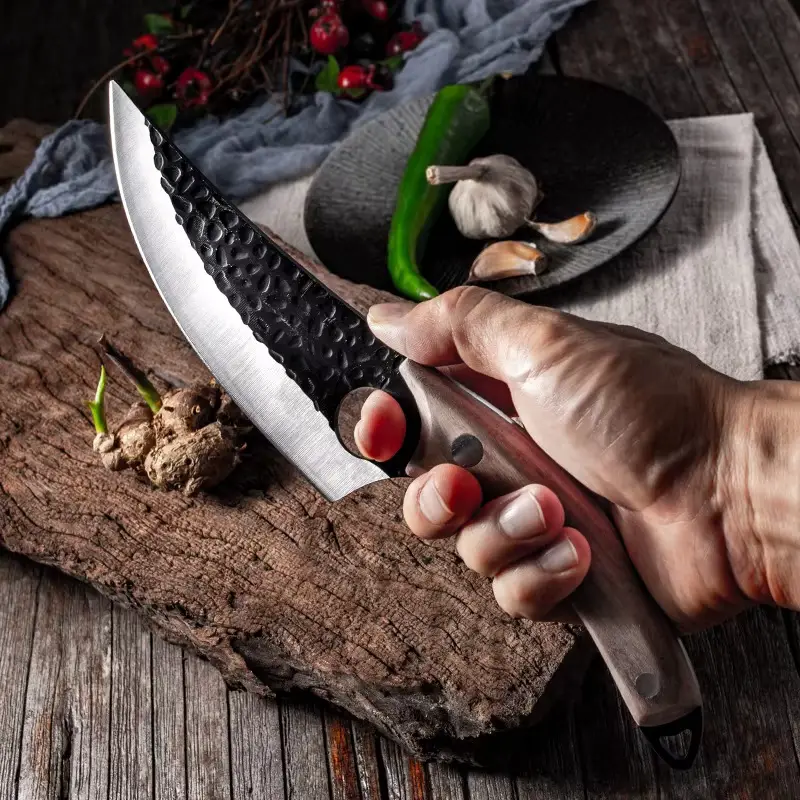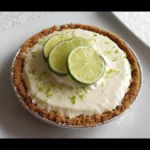Among the dazzling array of treasures found in a Hong Kong bakery or on a dim sum cart, there is one that holds a special, almost revered, place in my heart: the Mango Pancake. It’s not a pancake in the fluffy, breakfast-stack sense. Instead, it’s a delicate, ethereal creation that is pure, unadulterated bliss. I remember my first encounter with one as a child, presented like a soft, golden-yellow pillow on a small plate. I was intrigued by its simple, elegant form. The first bite was a revelation. A paper-thin, tender crepe gave way to a cloud of lightly sweetened, chilled whipped cream, which in turn revealed a heart of intensely sweet, succulent fresh mango. It was a textural masterpiece—soft, creamy, chewy, and juicy all at once. It tasted like a tropical dream. For years, I was too intimidated to even attempt making them at home, convinced that the paper-thin, perfectly yellow crepe and the stable, billowy cream were forms of kitchen alchemy beyond my reach. This recipe is the result of finally conquering that fear. It’s a carefully crafted guide born from many trials and even more delicious errors, designed to demystify the process. Now, creating these little pillows of joy has become a cherished ritual, a way to bring the unique magic of a Hong Kong dessert shop right into my own kitchen and share that unforgettable taste of sweet, creamy, tropical perfection with the people I love.
The Ultimate Hong Kong Mango Pancake: A Guide to the Iconic Dim Sum Dessert
Welcome to your complete guide to crafting the legendary Hong Kong-style Mango Pancake. This beloved Cantonese dessert is a testament to the idea that elegance lies in simplicity. Unlike its breakfast counterpart, this is a delicate, no-bake dessert crepe, filled with a generous cloud of whipped cream and sweet, fresh mango chunks, then folded into a neat, rectangular pillow. It’s a light, refreshing, and incredibly satisfying treat that is the perfect, cooling finale to a dim sum feast or a delightful afternoon indulgence.
This recipe will walk you through every step, from creating the impossibly thin, tender crepes to whipping a perfectly stable cream filling, ensuring you can replicate this bakery-quality dessert at home.
What Makes a Hong Kong Mango Pancake So Special?
The genius of the Hong Kong Mango Pancake lies in its perfect symphony of textures and temperatures. It’s a study in contrasts that come together in perfect harmony:
- The Delicate Crepe: The outer layer is a thin, soft, and pliable crepe with a signature pale-yellow hue. It’s not meant to be crispy or browned, but rather to serve as a tender, chewy blanket for the filling.
- The Airy Cream: The filling is not a heavy pastry cream, but a light, billowy, and lightly sweetened whipped cream. It provides a cool, cloud-like texture that melts in your mouth.
- The Sweet Mango: At the center lies a generous piece of ripe, succulent mango, providing a burst of sweet, tropical, and slightly tangy flavor that cuts through the richness of the cream.
- Served Chilled: The entire dessert is served cold, making it an incredibly refreshing and palate-cleansing treat, especially after a savory meal.
The Anatomy of Perfection: A Deep Dive into the Three Key Components
To create a truly exceptional mango pancake, we must master its three core elements.
The Crepe: A Delicate, Golden Blanket
The crepe is the foundation, and its texture is paramount. The goal is a paper-thin, soft, and slightly chewy wrapper that won’t tear when folded.
- The Flour: A combination of all-purpose flour and cornstarch is used. The cornstarch lowers the protein content, which inhibits gluten development and results in a more tender, delicate crepe.
- The Color: The signature pale-yellow color comes from the egg yolks. There should be no browning; this is achieved by cooking the crepes over very low heat.
- The Technique: Sifting the dry ingredients, resting the batter, and using a good non-stick pan are the three pillars of perfect crepe-making.
The Cream: A Cloud of Light, Airy Sweetness
The cream filling needs to be light and fluffy, but also stable enough to hold its shape when the pancake is folded and sliced.
- The Cream: Use a high-fat heavy whipping cream (at least 35% fat content). The fat is what allows the cream to whip up and hold air. Ensure the cream, the bowl, and the whisk are all thoroughly chilled before you begin.
- The Stabilizer: This is the professional secret to a cream filling that doesn’t weep or collapse. A tiny amount of bloomed gelatin, whisked into the cream, gives it incredible stability without affecting the flavor or texture. This step is a game-changer and ensures your pancakes hold up beautifully, even if made a few hours in advance.
The Mango: The Sweet, Tropical Jewel
The quality of your mango will define the final flavor of the dessert.
- The Best Variety: As with mango pudding, Ataulfo (Honey/Champagne) mangoes are the superior choice. Their flesh is silky-smooth, non-fibrous, and has a deep, honeyed sweetness that is perfect for this application.
- The Cut: You want to cut the mango into thick, generous batons or chunks. This ensures you get a substantial, juicy bite of fruit in the center of every pancake.
Complete Ingredients for Authentic Mango Pancakes
This recipe is broken down into two main components for clarity: the crepes and the filling.
Yields: 8-10 pancakes
Prep time: 30 minutes
Chilling time: 1 hour
Cook time: 20 minutes
For the Crepe Batter:
- 1 large egg
- 2 large egg yolks
- 40g (3 tablespoons) granulated sugar
- 240ml (1 cup) whole milk
- 80g (2/3 cup) all-purpose flour
- 20g (2.5 tablespoons) cornstarch
- 20g (1.5 tablespoons) unsalted butter, melted and cooled
- Pinch of salt
For the Mango and Cream Filling:
- 360ml (1.5 cups) cold heavy whipping cream (at least 35% fat)
- 40g (1/3 cup) confectioners’ (powdered) sugar, sifted
- 1 teaspoon unflavored powdered gelatin
- 1 tablespoon cold water
- 1-2 large ripe Ataulfo mangoes, peeled and cut into thick slices or chunks
Step-by-Step Instructions: From Batter to Blissful Bite
Follow these detailed steps carefully for a flawless and delicious result.
Step 1: Make and Chill the Crepe Batter
- Whisk Wet Ingredients: In a large bowl, whisk together the whole egg, egg yolks, and granulated sugar until the mixture is pale and slightly frothy. Whisk in the whole milk until combined.
- Sift in Dry Ingredients: Sift the all-purpose flour, cornstarch, and salt directly into the wet ingredients. Whisk gently until the batter is smooth and no lumps remain.
- Add Melted Butter: Whisk in the cooled, melted butter until fully incorporated.
- Strain the Batter: For an ultra-smooth crepe, strain the batter through a fine-mesh sieve into a clean bowl or pitcher. This will catch any small lumps of flour.
- Chill (Crucial Step): Cover the batter with plastic wrap and let it rest in the refrigerator for at least 1 hour. This step allows the flour to fully hydrate and the gluten to relax, which is the key to a tender, non-rubbery crepe.
Step 2: Cook the Thin, Delicate Crepes
- Prepare Your Station: Lightly whisk the chilled batter, as it may have separated slightly. Heat an 8-inch non-stick skillet over low heat. This is very important for preventing browning. You do not need to grease the pan if it is a good quality non-stick.
- Pour the Batter: Pour about 1/4 cup of batter into the center of the warm skillet. Immediately tilt and swirl the pan to spread the batter into a thin, even circle.
- Cook Gently: Cook on low heat for 1-2 minutes. The crepe is done when the surface looks dry and matte, and the edges begin to lift slightly from the pan. You only need to cook one side. There is no need to flip the crepe.
- Remove and Cool: Gently slide the crepe out of the pan onto a large plate or a piece of parchment paper. Repeat with the remaining batter, stacking the finished crepes on top of each other. Let them cool completely to room temperature.
Step 3: Prepare the Stabilized Cream Filling
- Bloom the Gelatin: In a small, microwave-safe bowl, sprinkle the 1 teaspoon of gelatin over the 1 tablespoon of cold water. Let it sit for 5-10 minutes to bloom.
- Whip the Cream: In a large, chilled bowl, use a hand mixer or a stand mixer with a whisk attachment to whip the cold heavy cream and sifted confectioners’ sugar on medium-high speed.
- Melt the Gelatin: Once the cream starts to thicken, microwave the bloomed gelatin in 5-second bursts until it has just melted into a clear liquid (it should take 5-10 seconds total). Do not let it get hot.
- Temper and Add Gelatin: With the mixer on low speed, slowly stream the melted gelatin into the whipping cream. Once it’s all in, turn the mixer back up to medium-high.
- Whip to Stiff Peaks: Continue to whip until the cream is thick and holds stiff peaks. This means when you lift the whisk out of the cream, the peak that forms holds its shape and doesn’t flop over.
Step 4: Assemble the Mango Pancakes
- Prepare for Assembly: Lay one cooled crepe on a clean work surface, cooked-side up (this will be the inside).
- Add the Filling: Spoon a generous dollop of the whipped cream into the center of the crepe.
- Add the Mango: Place a thick slice or a few chunks of fresh mango on top of the cream.
- Add More Cream: Top the mango with another small dollop of cream to encase it.
- Fold into a Pillow: Fold the pancake like you would a burrito. Fold the bottom edge up over the filling. Then, fold in the left and right sides. Finally, fold the top edge down to create a neat, rectangular pillow.
- Chill Before Serving: Place the finished pancake, seam-side down, on a platter. Repeat with the remaining crepes. For the best flavor and texture, chill the assembled pancakes in the refrigerator for at least 30 minutes before serving. This allows the filling to set and the flavors to meld.
Nutrition Facts (Estimated)
- Servings: 8-10 pancakes
- Calories per serving: Approximately 280-340 kcal
Preparation and Cooking Time
- Active Preparation Time: 50 minutes
- Chilling/Resting Time: 1 hour 30 minutes
- Total Time: Approximately 2 hours 20 minutes
How to Serve and Enjoy Your Mango Pancakes
These delicate desserts are best served simply to let their flavors shine.
- Serve Chilled: They are meant to be a cool and refreshing dessert. Serve them straight from the refrigerator.
- The Classic Pillow: Serve them whole, seam-side down, on a small dessert plate.
- Sliced for Sharing: For a beautiful presentation, use a sharp knife to slice the pancake in half diagonally, revealing the beautiful cross-section of cream and mango inside.
- With a Dusting: A light dusting of confectioners’ sugar just before serving can add a touch of extra elegance.
5 Pro-Tips for Flawless, Bakery-Quality Mango Pancakes
- A Good Non-Stick Pan is Non-Negotiable: This is the single most important piece of equipment for this recipe. A high-quality non-stick surface is essential for cooking the crepes without any oil and for allowing them to slide out of the pan easily without tearing.
- Resting the Batter is Mandatory: Don’t be tempted to skip the 1-hour chilling time for the crepe batter. This step is critical for a tender, delicate result. It allows the starches in the flour to fully absorb the liquid and lets the gluten relax.
- Low and Slow Heat for the Perfect Crepe: The goal is a pale yellow, not a golden brown, crepe. Cooking over very low heat ensures the crepe cooks through evenly without developing any color, giving you that authentic look and soft texture.
- The Gelatin Secret for Stable Cream: This is the game-changing tip that elevates your homemade pancakes to professional quality. Stabilizing the cream with a small amount of gelatin ensures your filling stays light and airy, but won’t become watery or collapse, even after several hours in the fridge.
- Don’t Overfill the Pancakes: While it’s tempting to load them up with cream and mango, overfilling is the number one cause of tearing and bursting. A generous but sensible amount of filling will ensure you can fold them into a neat, secure pillow.
Frequently Asked Questions (FAQ)
1. Why are my crepes tearing when I try to remove them from the pan?
This can be due to a few reasons:
- The pan isn’t non-stick enough.
- The heat is too high, causing them to stick.
- The batter wasn’t rested long enough, resulting in a weaker crepe.
- You’re trying to remove it too early. Wait until the surface is fully matte and the edges are visibly lifting.
2. My whipped cream became runny after a while. What happened?
This happens when the cream is not stable enough. The best way to prevent this is to use the gelatin stabilization method described in the recipe. Other contributing factors can be not whipping the cream to stiff peaks, or the cream, bowl, and whisks not being cold enough to begin with.
3. Can I make the components ahead of time?
Yes! You can make the crepes a day in advance. Stack them with small squares of parchment paper in between each one to prevent sticking, wrap them tightly in plastic wrap, and store them in the refrigerator. The whipped cream is best made closer to the assembly time, but with the gelatin stabilizer, it will hold well in the fridge for several hours.
4. Can I use a different fruit instead of mango?
Absolutely. While mango is the classic, this dessert is wonderful with other soft, sweet fruits. Fresh strawberries, peaches, or even bananas would be delicious alternatives. Just make sure the fruit is ripe and flavorful.
5. Why is my crepe batter lumpy?
Lumps usually form when the dry ingredients are not sifted or when the batter is not whisked thoroughly. The best way to guarantee a perfectly smooth batter is to follow the recipe and strain the batter through a fine-mesh sieve after mixing. This quick step catches any and all lumps.
Conclusion: More Than a Dessert, It’s a Delicious Memory
The Hong Kong Mango Pancake is a delicate dance of texture and flavor, a dessert that is both incredibly simple in its concept and deeply sophisticated in its effect. Mastering the thin crepe and the stable cream is a rewarding baking skill that unlocks the door to this iconic treat. Each soft, pillowy bite is a taste of pure joy—a cool, creamy, tropical escape that brings the unique and wonderful experience of a Hong Kong dessert house right to your table.
Print
Hong Kong Style Mango Pancake recipe
Ingredients
For the Crepe Batter:
-
1 large egg
-
2 large egg yolks
-
40g (3 tablespoons) granulated sugar
-
240ml (1 cup) whole milk
-
80g (2/3 cup) all-purpose flour
-
20g (2.5 tablespoons) cornstarch
-
20g (1.5 tablespoons) unsalted butter, melted and cooled
-
Pinch of salt
For the Mango and Cream Filling:
-
360ml (1.5 cups) cold heavy whipping cream (at least 35% fat)
-
40g (1/3 cup) confectioners’ (powdered) sugar, sifted
-
1 teaspoon unflavored powdered gelatin
-
1 tablespoon cold water
-
1-2 large ripe Ataulfo mangoes, peeled and cut into thick slices or chunks
Instructions
Step 1: Make and Chill the Crepe Batter
-
Whisk Wet Ingredients: In a large bowl, whisk together the whole egg, egg yolks, and granulated sugar until the mixture is pale and slightly frothy. Whisk in the whole milk until combined.
-
Sift in Dry Ingredients: Sift the all-purpose flour, cornstarch, and salt directly into the wet ingredients. Whisk gently until the batter is smooth and no lumps remain.
-
Add Melted Butter: Whisk in the cooled, melted butter until fully incorporated.
-
Strain the Batter: For an ultra-smooth crepe, strain the batter through a fine-mesh sieve into a clean bowl or pitcher. This will catch any small lumps of flour.
-
Chill (Crucial Step): Cover the batter with plastic wrap and let it rest in the refrigerator for at least 1 hour. This step allows the flour to fully hydrate and the gluten to relax, which is the key to a tender, non-rubbery crepe.
Step 2: Cook the Thin, Delicate Crepes
-
Prepare Your Station: Lightly whisk the chilled batter, as it may have separated slightly. Heat an 8-inch non-stick skillet over low heat. This is very important for preventing browning. You do not need to grease the pan if it is a good quality non-stick.
-
Pour the Batter: Pour about 1/4 cup of batter into the center of the warm skillet. Immediately tilt and swirl the pan to spread the batter into a thin, even circle.
-
Cook Gently: Cook on low heat for 1-2 minutes. The crepe is done when the surface looks dry and matte, and the edges begin to lift slightly from the pan. You only need to cook one side. There is no need to flip the crepe.
-
Remove and Cool: Gently slide the crepe out of the pan onto a large plate or a piece of parchment paper. Repeat with the remaining batter, stacking the finished crepes on top of each other. Let them cool completely to room temperature.
Step 3: Prepare the Stabilized Cream Filling
-
Bloom the Gelatin: In a small, microwave-safe bowl, sprinkle the 1 teaspoon of gelatin over the 1 tablespoon of cold water. Let it sit for 5-10 minutes to bloom.
-
Whip the Cream: In a large, chilled bowl, use a hand mixer or a stand mixer with a whisk attachment to whip the cold heavy cream and sifted confectioners’ sugar on medium-high speed.
-
Melt the Gelatin: Once the cream starts to thicken, microwave the bloomed gelatin in 5-second bursts until it has just melted into a clear liquid (it should take 5-10 seconds total). Do not let it get hot.
-
Temper and Add Gelatin: With the mixer on low speed, slowly stream the melted gelatin into the whipping cream. Once it’s all in, turn the mixer back up to medium-high.
-
Whip to Stiff Peaks: Continue to whip until the cream is thick and holds stiff peaks. This means when you lift the whisk out of the cream, the peak that forms holds its shape and doesn’t flop over.
Step 4: Assemble the Mango Pancakes
-
Prepare for Assembly: Lay one cooled crepe on a clean work surface, cooked-side up (this will be the inside).
-
Add the Filling: Spoon a generous dollop of the whipped cream into the center of the crepe.
-
Add the Mango: Place a thick slice or a few chunks of fresh mango on top of the cream.
-
Add More Cream: Top the mango with another small dollop of cream to encase it.
-
Fold into a Pillow: Fold the pancake like you would a burrito. Fold the bottom edge up over the filling. Then, fold in the left and right sides. Finally, fold the top edge down to create a neat, rectangular pillow.
-
Chill Before Serving: Place the finished pancake, seam-side down, on a platter. Repeat with the remaining crepes. For the best flavor and texture, chill the assembled pancakes in the refrigerator for at least 30 minutes before serving. This allows the filling to set and the flavors to meld.
Nutrition
- Serving Size: one normal portion
- Calories: 280-340 kcal






